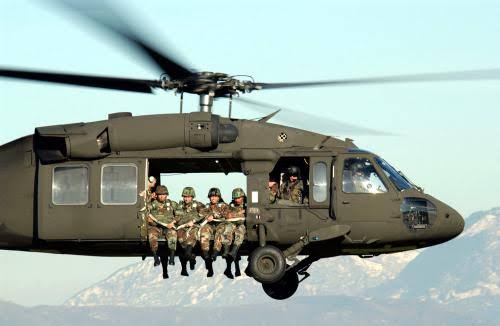UH 60 Technical Specifications and Performance Review
UH 60 Technical Specifications and Performance Review
Blog Article
The Impact of Sustainable Practices on the Future of Aircraft Operations and Emissions Reduction
As the aeronautics industry encounters increasing scrutiny over its environmental effect, the fostering of lasting techniques becomes a critical path toward future airplane operations and discharges reduction. Technologies in sustainable air travel fuels and advancements in crossbreed propulsion technologies stand at the leading edge of this makeover, encouraging considerable decreases in greenhouse gas emissions. Nevertheless, the successful combination of these initiatives depends upon a range of variables, consisting of regulatory frameworks and market cooperation. The question remains: exactly how will these evolving methods reshape the dynamics of air travel and add to an extra lasting future?

Summary of Sustainable Practices
Sustainable techniques in aircraft procedures incorporate a variety of strategies focused on reducing environmental impact while maintaining operational performance. These techniques are essential in the air travel market's commitment to decreasing its carbon impact and sticking to worldwide environmental requirements. Secret campaigns consist of optimizing flight courses to decrease gas consumption, improving maintenance procedures to ensure aircraft operate at peak effectiveness, and executing sophisticated technologies such as winglets and lightweight products that enhance the rules of aerodynamics.

Training and engaging personnel on sustainability methods additionally play an important duty, cultivating a culture of environmental responsibility within companies. On the whole, the assimilation of these sustainable practices not just helps in reducing discharges yet also boosts the long-term practicality of the air travel sector, ensuring it satisfies the needs of both customers and regulatory bodies while adding to worldwide sustainability goals.
Innovative Gas Alternatives
Various cutting-edge fuel options are becoming essential services to reduce the aeronautics sector's reliance on conventional nonrenewable fuel sources. Amongst these choices, Sustainable Aeronautics Gas (SAFs) have actually gained significant attention because of their prospective to lower lifecycle greenhouse gas exhausts by up to 80% compared to conventional jet fuels. SAFs are stemmed from numerous feedstocks, including waste oils, farming residues, and also algae, making them a flexible alternative for the sector.
One more promising choice is hydrogen gas, which, when utilized in fuel cells, generates just water vapor as a byproduct. Furthermore, electric propulsion systems are being explored, leveraging battery innovation to power airplane.
Lastly, biofuels stemmed from biomass are being checked out, providing a renewable alternative that can be combined with traditional gas. Collectively, these cutting-edge gas alternatives stand for a critical step towards accomplishing a lasting air travel environment, straightening with international discharges reduction targets and boosting the market's environmental stewardship.
Technological Developments in Aviation

Just how can technical developments reshape the future of aeronautics? Advancements such as electrical and hybrid propulsion systems are at the forefront, appealing substantial decreases in gas intake and greenhouse gas exhausts.
Furthermore, the execution of sophisticated materials, such as light-weight compounds, adds to enhanced aerodynamics and gas efficiency. Making use of expert system and maker learning in flight procedures optimizes path planning and lowers fuel shed by allowing real-time changes based on weather and website traffic conditions. Furthermore, the advancement of independent and from another location piloted airplane systems stands to reinvent freight and passenger transportation, potentially raising effectiveness while decreasing human mistake.
Furthermore, lasting aeronautics innovations, including sophisticated air website traffic monitoring systems, can decrease and streamline operations blockage, causing lower discharges during flight. These improvements jointly stand for a standard change in aviation, assuring a future where sustainability and operational effectiveness are intertwined, therefore sustaining the market's dedication to decreasing its environmental impact.

Governing Framework and Compliance
In light of the growing emphasis on environmental stewardship within the air travel market, the regulative structure regulating airplane operations is developing to promote lasting methods. Regulative bodies, such as the International Civil Aviation Organization (ICAO) and numerous national aeronautics authorities, are introducing stringent guidelines focused on lowering emissions and boosting operational efficiency.
These guidelines commonly consist moved here of the fostering of Sustainable Aviation Fuel (SAF), which has actually been acknowledged as an essential element in accomplishing lower carbon footprints. Furthermore, conformity with these guidelines needs airline companies to apply functional practices and advanced innovations, such as enhanced trip paths and boosted air traffic administration, to decrease fuel intake.
Furthermore, the enforcement of exhausts trading systems and carbon offsetting initiatives is coming to be progressively widespread, engaging airline companies to check and report their exhausts precisely. Non-compliance can result in significant fines, therefore pushing operators to focus on sustainability in their business designs.
Ultimately, the progressing governing landscape not only drives advancement and investment in green modern technologies however also promotes a culture of responsibility within the air travel sector. As these frameworks remain to develop, the concentrate on lasting practices will be indispensable to attaining the industry's lasting environmental objectives.
Future Fads in Airplane Workflow
As the aeronautics market adapts to a significantly strict governing environment, future trends in airplane operations are established to concentrate on innovative services that further enhance sustainability and effectiveness - uh 60. Trick developments will likely include the fostering of go right here sophisticated air traffic management systems, which utilize real-time data and synthetic knowledge to enhance flight paths, decreasing fuel consumption and exhausts
Another substantial fad is the raised combination of sustainable aeronautics fuels (SAFs) These choices to conventional jet gas, originated from sustainable resources, can dramatically reduce lifecycle greenhouse gas emissions. The market's dedication to SAFs will likely accelerate as airline companies team up with gas manufacturers to guarantee schedule and cost-effectiveness.
Furthermore, the press towards electrification and hybrid propulsion systems is gaining momentum. Emerging airplane styles will integrate these innovations, providing quieter and a lot more efficient procedures, specifically for short-haul flights.
Final Thought
The adoption of lasting air travel fuels, combined with improvements in electrical and hybrid propulsion systems, is vital for decreasing lifecycle greenhouse gas emissions. Maximizing trip courses and accepting cutting-edge technologies add to a quieter and a lot more ecologically pleasant aviation market.
Innovations in lasting air travel fuels and advancements in hybrid propulsion technologies stand at the forefront of this transformation, encouraging significant reductions in greenhouse gas discharges.Many ingenious gas options are arising as essential options to minimize the aeronautics sector's reliance on conventional fossil fuels - uh 60. Amongst these choices, Sustainable Aviation Gas (SAFs) have obtained substantial attention due to their possible to reduce lifecycle greenhouse gas exhausts by up to 80% contrasted to traditional jet fuels.Another substantial fad is the boosted assimilation of sustainable air travel fuels Going Here (SAFs) The adoption of lasting air travel gas, combined with improvements in electrical and hybrid propulsion systems, is essential for lessening lifecycle greenhouse gas emissions
Report this page